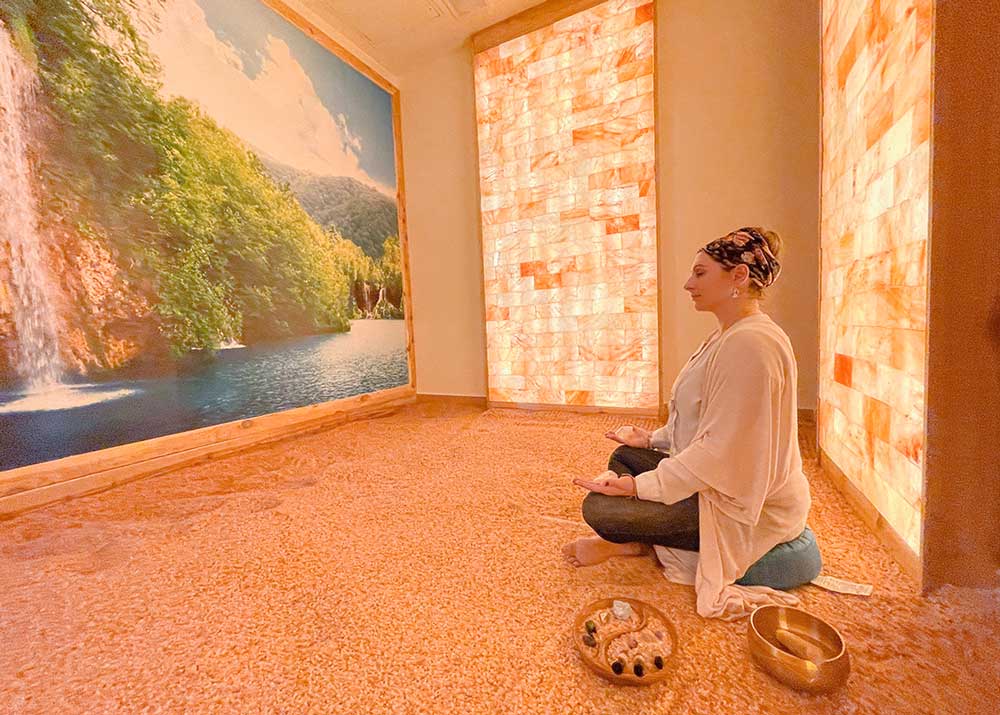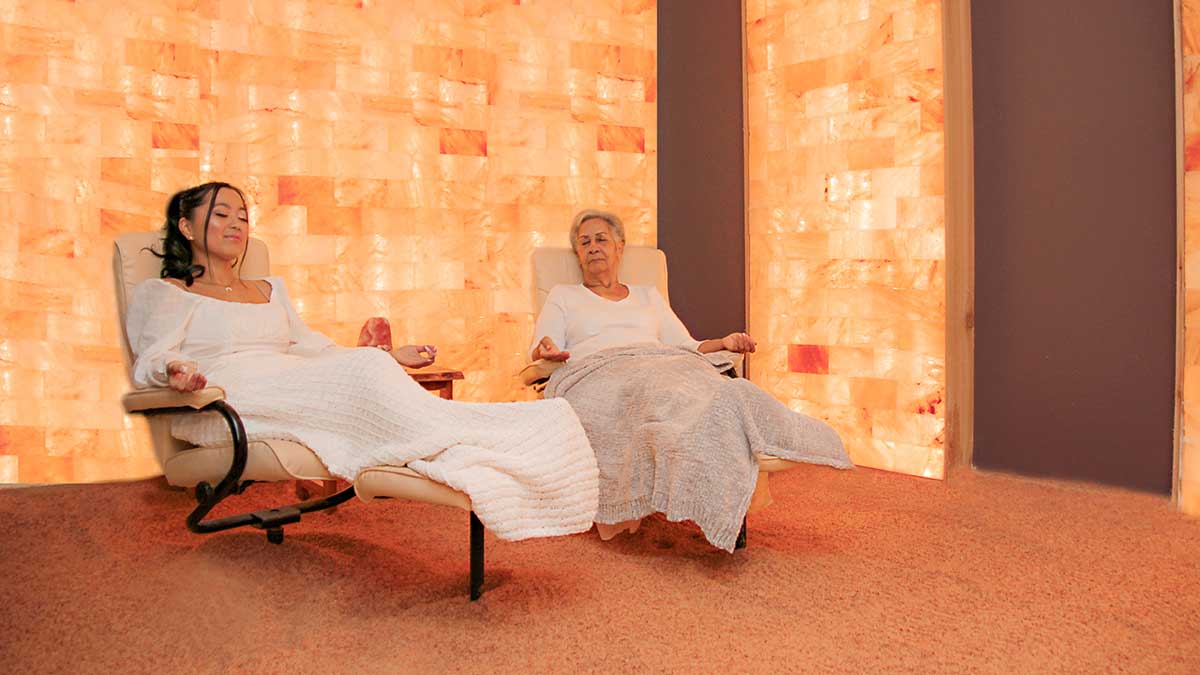Salt room therapy, also known as halotherapy, is a natural therapy that involves sitting in a room filled with salt particles. The therapy is inspired by the natural healing properties of salt caves and mines, which have long been used for their therapeutic effects on respiratory conditions.
During a salt room therapy session, clients sit in a comfortable chair or recline on a salt-covered bed while inhaling the salty air. The salt particles, dispersed into the air using a halogenerator, are believed to have various health benefits when inhaled.
Salt room therapy is increasingly being offered at wellness centers and spas as a natural method of improving respiratory and skin conditions, reducing stress, and promoting overall well-being.
Salt room therapy offers a variety of potential health benefits. Some of the most commonly cited benefits of salt room therapy include improvement of respiratory conditions, such as asthma and allergies, relief of skin conditions, such as eczema and acne, reduced stress and improved sleep, and increased energy and overall well-being.
The exact mechanisms by which salt room therapy may produce these benefits are not fully understood. Still, the salt particles may help reduce inflammation, clear mucus from the respiratory system, and provide a calming and relaxing effect. Many people have reported significant improvements in their symptoms and overall well-being after undergoing this therapy.
Table of Contents
The History of Salt Room Therapy
The origins of salt therapy as a natural healing method can be traced back to ancient civilizations, where salt was used for a variety of medicinal purposes. In particular, the use of salt mines and salt caves for therapeutic purposes has a long history.
In the 19th century, European doctors recommended spending time in salt caves and mines to treat respiratory conditions such as tuberculosis. The salty air in these natural environments was believed to have a beneficial effect on the respiratory system, and “speleotherapy” (salt cave therapy) became popular.
In the 20th century, artificial salt rooms, also known as halochambers, became more common to replicate the therapeutic effects of natural salt mines and caves.
Today, salt room therapy is offered at many wellness centers and spas to improve respiratory and skin conditions, reduce stress, and promote overall well-being.
How Salt Room Therapy Works
Salt room therapy involves sitting in a room filled with salt particles, which are dispersed into the air using a device called a halogenerator. During a session, clients sit in a comfortable chair or recline on a salt-covered bed while inhaling the salty air.
The salt particles are believed to have various health benefits when inhaled, as they can help clear out mucus and reduce inflammation in the respiratory system. In addition, the salt particles can help cleanse and exfoliate the skin, improving skin health.
The exact mechanisms behind the health benefits of salt room therapy are not fully understood, but many people have reported positive results from using this natural therapy. Salt room therapy sessions typically last around 45 minutes and may be repeated regularly for maximum benefit.
Potential Health Benefits of Salt Room Therapy
Salt room therapy is believed to have many potential health benefits, including improvement of respiratory conditions such as asthma and allergies, relief of skin conditions such as eczema and acne, reduced stress and improved sleep, and increased energy and overall well-being.
Halotherapy for Respiratory Conditions
Salt room therapy can be effective in improving respiratory conditions, such as asthma and allergies, due to the properties of salt particles.
When inhaled, the salt particles are thought to help clear out mucus and reduce inflammation in the respiratory system. This can lead to improved breathing and reduced symptoms of respiratory conditions.
Some studies have shown that salt room therapy can effectively reduce the frequency and severity of asthma attacks and improve symptoms of allergies such as sneezing, runny nose, and itchy eyes.
Salt Therapy for Skin Conditions
Salt room therapy may also benefit skin conditions such as eczema and acne. Salt particles dispersed into the air during a salt room therapy session can help cleanse and exfoliate the skin, leading to improved skin health.
The salt particles can also help reduce inflammation and irritation, which may benefit individuals with eczema or other inflammatory skin conditions.
Some people with acne have also reported positive results from using salt room therapy, as the salt particles may help to unclog pores and reduce the appearance of blemishes.
Halotherapy for Stress Relief and Sleep Conditions
Salt room therapy may also have stress-reducing effects and improve sleep. The warm, relaxing atmosphere of the salt room, combined with the salt particles’ calming properties, may help reduce stress and promote a sense of relaxation.
Some people find that salt room therapy helps them feel more peaceful and calm, leading to better sleep. The salt particles also help to reduce inflammation and promote overall relaxation in the body, which can contribute to improved sleep.
Salt Therapy for Increased Energy and Overall Well Being
Salt room therapy has also been shown to increase energy and promote overall well-being. The relaxing atmosphere of the salt room and the calming properties of the salt particles may help to reduce stress and promote a sense of relaxation, which can contribute to an overall feeling of well-being.
In addition, improving respiratory and skin conditions that may result from salt room therapy can also contribute to increased energy and a sense of improved health.

Precautions and Considerations of Salt Therapy
Before starting treatment, you may want to consider some potential contraindications for salt room therapy.
Individuals with severe respiratory conditions, such as severe asthma or COPD, should consult their healthcare provider before trying salt room therapy, as it may not be safe for them.
In addition, pregnant individuals or those who have a history of heart disease should also consult with their healthcare provider before starting salt room therapy.
It is also essential to be aware of any allergies or sensitivities to salt, as this may be a contraindication for salt room therapy.
It is always best to consult with a healthcare professional before starting any new therapy to ensure that it is safe and appropriate for your individual needs.
Conclusion
While more research is needed to fully understand the mechanisms behind halotherapy’s benefits, many people have reported positive results from using salt room therapy. As noted above, salt therapy has a number of potential health benefits and may be a valuable natural method of improving health and well-being for many people.
If you are considering trying salt room therapy, be sure to do your research and choose a reputable salt room therapy provider to ensure the best possible experience. Don’t be afraid to ask questions and discuss any concerns with your healthcare professional or the provider of the salt room therapy.
With some research and care, salt room therapy may be a valuable natural method of improving your health and well-being. So, it is worth giving it a try.
© All images and text are the property of WellCome OM Integral Healing & Learning Center and may not be reused without our express permission.





